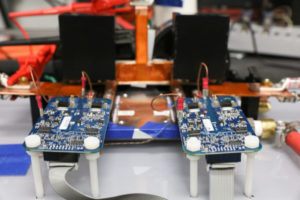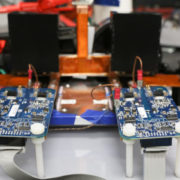Oak Ridge National Lab Unveils 120-Kilowatt Wireless EV Charging System
November 02, 2018

Researchers at Oak Ridge National Laboratory recently demonstrated a 120-kilowatt wireless EV charging system. The system is six times more powerful than one developed by ORNL researchers just two years ago.
In a lab demonstration, the system transferred power at the same rate as a wired Tesla Supercharger and at more than two times the rate of the wired 50-kilowatt DC fast chargers commonly installed by non-Tesla EV charging network operators.
The wireless charging system unveiled by ORNL in March 2016 transferred 20 kilowatts at 90 percent efficiency. The new 120-kilowatt system provided six times the power with 97 percent efficiency. That efficiency rate, according to ORNL, is comparable to existing wired EV fast chargers.
Researchers achieved the power delivery and efficiency leaps while maintaining the same footprint as the 20-kilowatt system.
“We went significantly up in power, but the footprint remained the same and the power electronics size actually shrunk,” project lead Veda Galigekere told Greentech Media in an interview. Galigekere is a researcher with ORNL’s Power Electronics and Electric Machinery Group.
Boosting power delivery and exploring partnerships with manufacturers
For the 120-kilowatt system, researchers used computer simulations to create new designs for the coils that generate the magnetic field that wirelessly transfers power. And then, “using silicon carbide-based power electronics, we co-optimized the whole system,” said Galigekere.
The system draws electricity from the grid and converts it to high-frequency alternating current, which generates a magnetic field across a six-inch gap of air. After the electricity is transferred to a second coil, it is converted back to direct current and stored in the vehicle battery pack.
Next steps for Galigekere’s team include research into bidirectional wireless power transfer — from grid to vehicle and back again — as well as continued improvement in the system’s power delivery rate.
On making the jump from 20 kilowatts to a 120-kilowatt wireless EV charging system, Galigekere said: “We are kind of ahead of the curve. But we want to stay ahead of the curve. By the time 120-kilowatt [technology] becomes a reality, we will be ahead of the curve again.”
The ORNL project team’s long-term goal is to develop a wireless charging system able to deliver 350 kilowatts.
The researchers are open to working with private-sector partners to advance the technology.
“We are talking, and we do talk, with several OEMs,” said Galigekere. He said it’s too early to comment on what potential partnerships might look like.
“We are open to, and we are looking forward to, partners to work on this,” he added.
Private-sector competition
The ORNL team has private-sector competitors in commercializing wireless EV charging technologies.
After completing 10 pilot projects in four countries, the Brooklyn-based wireless charging startup Hevo Inc. is transitioning to manufacturing. According to a recent profile of the company by a team of reporters at Bloomberg, Hevo plans to make thousands of units over the next 18 months to meet supply agreements signed with automakers and utilities.
WiTricity, a wireless charging company based in Watertown, Massachusetts, meanwhile, signed an intellectual property licensing agreement last month with Anjie Wireless, a China-based auto supplier. Anjie will use WiTricity’s technology to develop wireless charging systems for Chinese automakers. According to WiTricity, its Drive 11 system can deliver up to 11 kilowatts of power at 93 percent efficiency.
Dynamic roadway charging
The ORNL research team is also committed to developing on-road dynamic wireless charging. Such a system would enable automatic charging of EVs via wireless charging pads embedded in the road.
Galigekere said the pursuit of increased power delivery for stationary wireless charging of fleets and large trucks will complement efforts to use the technology for on-road applications.
“We believe higher power of power transmission with stationary charging can enable dynamic charging, too, because if you have dynamic charging at lower power, you will require a larger part of the roadway network to be embedded with coil,” he explained.
He went on: “But, as you go up in power, smaller sections of the roadway can have coil.”
Time and money spent on infrastructure build-out should go down, he said, as the power transfer level of the wireless system increases.




